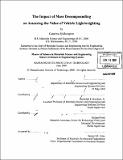The impact of mass decompounding on assessing the value of vehicle lightweighting
Author(s)
Bjelkengren, Catarina
DownloadFull printable version (22.85Mb)
Other Contributors
Massachusetts Institute of Technology. Dept. of Materials Science and Engineering.
Advisor
Randolph E. Kirchain, Jr. and Richard Roth.
Terms of use
Metadata
Show full item recordAbstract
Among consumers and manufacturers alike, there is an increasing realization about the need for fuel efficient vehicles. One effective way to accomplish this is through vehicle lightweighting, which can be achieved by material substitution, novel vehicle component design, and changes in processing. Although primary vehicle mass reduction is often associated with additional costs to the automaker, a decision to lightweight may, depending on when in the vehicle development process the decision is taken, result in additional secondary mass savings such that the value derived from lightweighting is greater than the costs. In this study, the concept of secondary mass savings, or mass decompounding, is developed using regression analysis. Moreover, the full, both primary and secondary, mass savings potential is assessed at different times in the vehicle development process. Lastly, powertrain and market trend modeling are employed to estimate the value of the compounded mass savings in terms of improved fuel economy and acceleration. This methodology is applied to a collected vehicle dataset in order to generate a model by which the value of and the subsystem-specific amount of secondary mass savings may be easily estimated during the early stages of vehicle development. In summary, this analysis may be employed to evaluate the economic competitiveness of vehicle lightweighting options at different times in the vehicle development process.
Description
Thesis (S.M.)--Massachusetts Institute of Technology, Dept. of Materials Science and Engineering, 2008. Includes bibliographical references (p. 121-125).
Date issued
2008Department
Massachusetts Institute of Technology. Department of Materials Science and EngineeringPublisher
Massachusetts Institute of Technology
Keywords
Materials Science and Engineering.